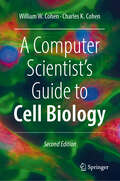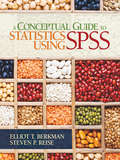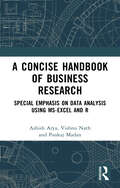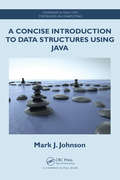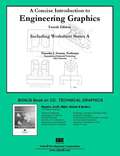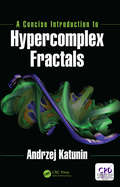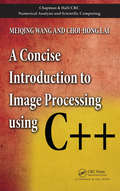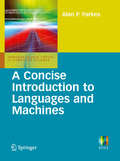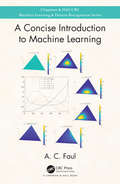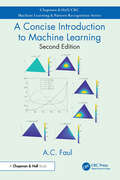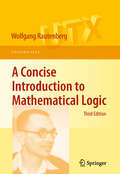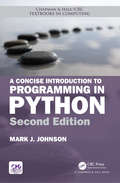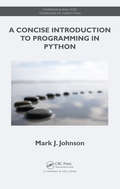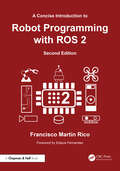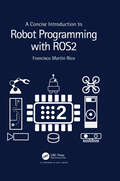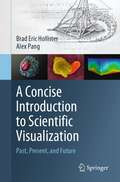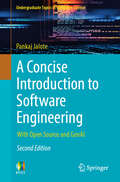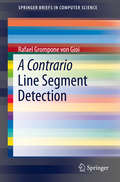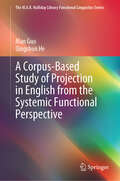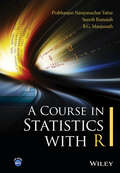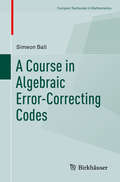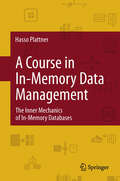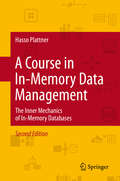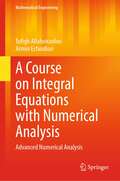- Table View
- List View
A Computer Scientist's Guide to Cell Biology
by William W. Cohen Charles K. CohenUnlike the structured world of computer science, biology is complex, evolving, and often lacks clean abstract models. This book aims to serve as a guide for computer scientists who need to understand cell biology, breaking the field into three parts: biological mechanics, experimental methods, and language/nomenclature. While biological mechanics, which investigates cellular-level details, is covered by many texts, this book also focuses on experimental methods – how biologists conduct experiments and gather data - and on helping the reader understand the language and terminology of biology, which is rich but challenging for non-biologists. A Computer Scientist's Guide to Cell Biology uses a metaphor of biology as a strange land with an unfamiliar language and customs. The goal of the book is to provide a high-level introduction to cell biology, simplifying concepts and relating them to familiar ideas from computer science, so that working computer scientists can more effectively understand read recent research papers and results.This Second Edition contains a number of updates, including discussions of CRISPR, advances in DNA Sequencing, and mRNA vaccines. It serves as an easy-to-read travel guide for computer scientists navigating the intricate and sometimes perplexing terrain of cell biology, offering insights into experimental methods and helping bridge the gap between the structured world of computer science and the complexities of biological systems.
A Conceptual Guide to Statistics Using SPSS
by Steven P. Reise Elliot T. BerkmanBridging an understanding of Statistics and SPSS.This unique text helps students develop a conceptual understanding of a variety of statistical tests by linking the ideas learned in a statistics class from a traditional statistics textbook with the computational steps and output from SPSS. Each chapter begins with a student-friendly explanation of the concept behind each statistical test and how the test relates to that concept. The authors then walk through the steps to compute the test in SPSS and the output, clearly linking how the SPSS procedure and output connect back to the conceptual underpinnings of the test. By drawing clear connections between the theoretical and computational aspects of statistics, this engaging text aids students' understanding of theoretical concepts by teaching them in a practical context.
A Concise Handbook of Business Research: Special Emphasis on Data Analysis Using MS-Excel and R
by Vishnu Nath Ashish Arya Pankaj MadanThis book deals with the basics of Research Methodology (RM) for Business Research and statistical analysis for dealing with data using two software: R (a free statistical analysis environment) and MS-Excel. Apart from the basic concepts of Research Methodology, the book contains an additional chapter on improving academic writing. It contains important details on plagiarism, citation and referencing in MS-Word, and improving project/dissertation writing using free online software. Print edition not for sale in South Asia (India, Sri Lanka, Nepal, Bangladesh, Pakistan or Bhutan)
A Concise Introduction to Data Structures using Java (Chapman And Hall/crc Textbooks In Computing Ser. #11)
by Mark J. JohnsonA student-friendly text, A Concise Introduction to Data Structures Using Java takes a developmental approach, starting with simpler concepts first and then building toward greater complexity. Important topics, such as linked lists, are introduced gradually and revisited with increasing depth. More code and guidance are provided at the beginning, al
A Concise Introduction to Hypercomplex Fractals
by Andrzej KatuninThis book presents concisely the full story on complex and hypercomplex fractals, starting from the very first steps in complex dynamics and resulting complex fractal sets, through the generalizations of Julia and Mandelbrot sets on a complex plane and the Holy Grail of the fractal geometry – a 3D Mandelbrot set, and ending with hypercomplex, multicomplex and multihypercomplex fractal sets which are still under consideration of scientists. I tried to write this book in a possibly simple way in order to make it understandable to most people whose math knowledge covers the fundamentals of complex numbers only. Moreover, the book is full of illustrations of generated fractals and stories concerned with great mathematicians, number spaces and related fractals. In the most cases only information required for proper understanding of a nature of a given vector space or a construction of a given fractal set is provided, nevertheless a more advanced reader may treat this book as a fundamental compendium on hypercomplex fractals with references to purely scientific issues like dynamics and stability of hypercomplex systems.
A Concise Introduction to Image Processing using C++ (Chapman & Hall/CRC Numerical Analysis and Scientific Computing Series)
by Meiqing Wang Choi-Hong LaiImage recognition has become an increasingly dynamic field with new and emerging civil and military applications in security, exploration, and robotics. Written by experts in fractal-based image and video compression, A Concise Introduction to Image Processing using C++ strengthens your knowledge of fundamentals principles in image acquisition, conservation, processing, and manipulation, allowing you to easily apply these techniques in real-world problems. The book presents state-of-the-art image processing methodology, including current industrial practices for image compression, image de-noising methods based on partial differential equations (PDEs), and new image compression methods, such as fractal image compression and wavelet compression. It begins with coverage of representation, and then moves on to communications and processing. It concludes with discussions of processing techniques based on image representations and transformations developed in earlier chapters. The accompanying downloadable resources contain code for all algorithms.Suitable as a text for any course on image processing, the book can also be used as a self-study resource for researchers who need a concise and clear view of current image processing methods and coding examples. The authors introduce mathematical concepts with rigor suitable for readers with some background in calculus, algebra, geometry, and PDEs. All algorithms described are illustrated with code implementation and many images compare the results of different methods. The inclusion of C++ implementation code for each algorithm described enables students and practitioners to build up their own analysis tool.
A Concise Introduction to Languages and Machines (Undergraduate Topics in Computer Science)
by Alan P. ParkesA Concise Introduction to Languages, Machines and Logic provides an accessible introduction to three key topics within computer science: formal languages, abstract machines and formal logic. Written in an easy-to-read, informal style, this textbook assumes only a basic knowledge of programming on the part of the reader. The approach is deliberately non-mathematical, and features: - Clear explanations of formal notation and jargon, - Extensive use of examples to illustrate algorithms and proofs, - Pictorial representations of key concepts, - Chapter opening overviews providing an introduction and guidance to each topic, - End-of-chapter exercises and solutions, - Offers an intuitive approach to the topics. This reader-friendly textbook has been written with undergraduates in mind and will be suitable for use on course covering formal languages, formal logic, computability and automata theory. It will also make an excellent supplementary text for courses on algorithm complexity and compilers.
A Concise Introduction to Machine Learning
by A.C. FaulThe emphasis of the book is on the question of Why – only if why an algorithm is successful is understood, can it be properly applied, and the results trusted. Algorithms are often taught side by side without showing the similarities and differences between them. This book addresses the commonalities, and aims to give a thorough and in-depth treatment and develop intuition, while remaining concise. This useful reference should be an essential on the bookshelves of anyone employing machine learning techniques. The author's webpage for the book can be accessed here.
A Concise Introduction to Machine Learning (Chapman & Hall/CRC Machine Learning & Pattern Recognition)
by A.C. FaulA Concise Introduction to Machine Learning uses mathematics as the common language to explain a variety of machine learning concepts from basic principles and illustrates every concept using examples in both Python and MATLAB®, which are available on GitHub and can be run from there in Binder in a web browser. Each chapter concludes with exercises to explore the content.The emphasis of the book is on the question of Why—only if “why” an algorithm is successful is understood, can it be properly applied and the results trusted. Standard techniques are treated rigorously, including an introduction to the necessary probability theory. This book addresses the commonalities of methods, aims to give a thorough and in-depth treatment and develop intuition for the inner workings of algorithms, while remaining concise.This useful reference should be essential on the bookshelf of anyone employing machine learning techniques, since it is born out of strong experience in university teaching and research on algorithms, while remaining approachable and readable.
A Concise Introduction to Mathematical Logic (Universitext)
by Wolfgang RautenbergTraditional logic as a part of philosophy is one of the oldest scientific disciplines and can be traced back to the Stoics and to Aristotle. Mathematical logic, however, is a relatively young discipline and arose from the endeavors of Peano, Frege, and others to create a logistic foundation for mathematics. It steadily developed during the twentieth century into a broad discipline with several sub-areas and numerous applications in mathematics, informatics, linguistics and philosophy. This book treats the most important material in a concise and streamlined fashion. The third edition is a thorough and expanded revision of the former. Although the book is intended for use as a graduate text, the first three chapters can easily be read by undergraduates interested in mathematical logic. These initial chapters cover the material for an introductory course on mathematical logic, combined with applications of formalization techniques to set theory. Chapter 3 is partly of descriptive nature, providing a view towards algorithmic decision problems, automated theorem proving, non-standard models including non-standard analysis, and related topics. The remaining chapters contain basic material on logic programming for logicians and computer scientists, model theory, recursion theory, Gödel's Incompleteness Theorems, and applications of mathematical logic. Philosophical and foundational problems of mathematics are discussed throughout the text. Each section of the seven chapters ends with exercises some of which of importance for the text itself. There are hints to most of the exercises in a separate file Solution Hints to the Exercises which is not part of the book but is available from the author's website.
A Concise Introduction to Programming in Python (Chapman & Hall/CRC Textbooks in Computing #12)
by Mark J. JohnsonA Concise Introduction to Programming in Python, Second Edition provides a hands-on and accessible introduction to writing software in Python, with no prior programming experience required. The Second Edition was thoroughly reorganized and rewritten based on classroom experience to incorporate: A spiral approach, starting with turtle graphics, and then revisiting concepts in greater depth using numeric, textual, and image data Clear, concise explanations written for beginning students, emphasizing core principles A variety of accessible examples, focusing on key concepts Diagrams to help visualize new concepts New sections on recursion and exception handling, as well as an earlier introduction of lists, based on instructor feedback The text offers sections designed for approximately one class period each, and proceeds gradually from procedural to object-oriented design. Examples, exercises, and projects are included from diverse application domains, including finance, biology, image processing, and textual analysis. It also includes a brief "How-To" sections that introduce optional topics students may be interested in exploring. The text is written to be read, making it a good fit in flipped classrooms. Designed for either classroom use or self-study, all example programs and solutions to odd-numbered exercises (except for projects) are available at: http://www.central.edu/go/conciseintro/.
A Concise Introduction to Programming in Python (Chapman And Hall/crc Textbooks In Computing Ser.)
by Mark J. JohnsonSuitable for newcomers to computer science, A Concise Introduction to Programming in Python provides a succinct, yet complete, first course in computer science using the Python programming language. The book features:Short, modular chapters with brief and precise explanations, intended for one class periodEarly introduction of basic procedural cons
A Concise Introduction to Robot Programming with ROS 2
by Francisco Martín RicoA Concise Introduction to Robot Programming with ROS2 provides the reader with the concepts and tools necessary to bring a robot to life through programming. It will equip the reader with the skills necessary to undertake projects with ROS2, the new version of ROS. It is not necessary to have previous experience with ROS2 as it will describe its concepts, tools, and methodologies from the beginning. Uses the two programming languages officially supported in ROS 2 (C++, mainly, and Python) Approaches ROS 2 from three different but complementary dimensions: the Community, Computation Graph, and the Workspace Includes a complete simulated robot, development and testing strategies, Behavior Trees, and Nav2 description, setup, and use A GitHub repository with code to assist readers It will appeal to motivated engineering students, engineers, and professionals working with robot programming.
A Concise Introduction to Robot Programming with ROS2
by Francisco Martín RicoA Concise Introduction to Robot Programming with ROS2 provides the reader with the concepts and tools necessary to bring a robot to life through programming. It will equip the reader with the skills necessary to undertake projects with ROS2, the new version of ROS. It is not necessary to have previous experience with ROS2 as it will describe its concepts, tools, and methodologies from the beginning. Key Features Uses the two programming languages officially supported in ROS2 (C++, mainly, and Python) Approaches ROS2 from three different but complementary dimensions: the Community, Computation Graph, and the Workspace Includes a complete simulated robot, development and testing strategies, Behavior Trees, and Nav2 description, setup, and use A GitHub repository with code to assist readers It will appeal to motivated engineering students, engineers, and professionals working with robot programming.
A Concise Introduction to Scientific Visualization: Past, Present, and Future
by Brad Eric Hollister Alex PangScientific visualization has always been an integral part of discovery, starting first with simplified drawings of the pre-Enlightenment and progressing to present day. Mathematical formalism often supersedes visual methods, but their use is at the core of the mental process. As historical examples, a spatial description of flow led to electromagnetic theory, and without visualization of crystals, structural chemistry would not exist. With the advent of computer graphics technology, visualization has become a driving force in modern computing. A Concise Introduction to Scientific Visualization – Past, Present, and Future serves as a primer to visualization without assuming prior knowledge. It discusses both the history of visualization in scientific endeavour, and how scientific visualization is currently shaping the progress of science as a multi-disciplinary domain.
A Concise Introduction to Software Engineering: With Open Source and GenAI (Undergraduate Topics in Computer Science)
by Pankaj JaloteSoftware engineering has changed: A software project today is likely to use large language models (LLMs) for some tasks and will employ some open-source software. It is therefore important to integrate open source and use of LLMs in teaching software engineering – a key goal of this textbook. This reader-friendly textbook/reference introduces a carefully curated set of concepts and practices essential for key tasks in software projects. It begins with a chapter covering industry-standard software, open-source tools, and the basics of prompt engineering for LLMs. The second chapter delves into project management, including development process models, planning, and team-working. Subsequent chapters focus on requirements analysis and specification, architecture design, software design, coding, testing, and application deployment. Each chapter presents concepts, practical methods, examples, the application of LLMs, and the role of open-source software. A companion website provides some comprehensive case studies, as well as teaching material including presentation slides. This textbook is ideal for an introductory course on software engineering where the objective is to develop knowledge and skills to execute a project—specifically in a team employing contemporary software engineering practices and using open source and LLMs. It is also suitable for professionals who want to be introduced to the systematic approach of software engineering and/or use of open source and LLMs. The author is a distinguished professor at IIIT-Delhi and a well-known academic in software engineering. He has served as vice president in Infosys Technologies Limited and as a visiting researcher at Microsoft Corporation. Reviews of the first edition: "This book's title provides an excellent description of its content. ... This compact volume is organized into eight well-focused chapters containing numerous examples and well-designed self-test exercises. Includes an excellent collection of references and a very useful index. Summing Up: Highly recommended. Upper-division undergraduate through professional readers; two-year technical program students." (J. Beidler, Choice, Vol. 46 (6)) "Jalote's intention in this book is to present just enough material to teach beginning software engineers what they need to know to do a development project that carries a smallproduct from conception through delivery. The result is a short book ... making this sort of book very attractive as a text for introductory software engineering. ... topics are well chosen and their discussion is good." (Christopher Fox, ACM Computing Reviews)
A Contrario Line Segment Detection (SpringerBriefs in Computer Science)
by Rafael Grompone von GioiThe reliable detection of low-level image structures is an old and still challenging problem in computer vision. This book leads a detailed tour through the LSD algorithm, a line segment detector designed to be fully automatic. Based on the a contrario framework, the algorithm works efficiently without the need of any parameter tuning. The design criteria are thoroughly explained and the algorithm's good and bad results are illustrated on real and synthetic images. The issues involved, as well as the strategies used, are common to many geometrical structure detection problems and some possible extensions are discussed.
A Corpus-Based Study of Projection in English from the Systemic Functional Perspective (The M.A.K. Halliday Library Functional Linguistics Series)
by Qingshun He Man GuoThis book presents a comprehensive study on the phenomenon of projection in English language, drawing upon Halliday’s systemic functional linguistics (SFL) model. It aims to clarify the grammatical status of projecting and projected clauses and explore their synchronic distribution features as well as diachronic evolution patterns. This book provides insights into the understanding of the grammatical status of projection-related clauses. Furthermore, the uncovering of historical evolution trends contributes to the literature on grammatical metaphor in SFL. From a practical standpoint, the empirical investigations into the relationship between projection and text technicality provide important implications for English teaching pedagogy and discourse analysis.
A Course In Statistics With R
by Prabhanjan N. Tattar Suresh Ramaiah B. G. ManjunathIntegrates the theory and applications of statistics using R "A Course in Statistics with R" has been written to bridge the gap between theory and applications and explain how mathematical expressions are converted into R programs. The book has been primarily designed as a useful companion for a Masters student during each semester of the course, but will also help applied statisticians in revisiting the underpinnings of the subject. With this dual goal in mind, the book begins with R basics and quickly covers visualization and exploratory analysis. Probability and statistical inference, inclusive of classical, nonparametric, and Bayesian schools, is developed with definitions, motivations, mathematical expression and R programs in a way which will help the reader to understand the mathematical development as well as R implementation. Linear regression models, experimental designs, multivariate analysis, and categorical data analysis are treated in a way which makes effective use of visualization techniques and the related statistical techniques underlying them through practical applications, and hence helps the reader to achieve a clear understanding of the associated statistical models. "Key features" Integrates R basics with statistical concepts Provides graphical presentations inclusive of mathematical expressions Aids understanding of limit theorems of probability with and without the simulation approach Presents detailed algorithmic development of statistical models from scratch Includes practical applications with over 50 data sets
A Course in Algebraic Error-Correcting Codes (Compact Textbooks in Mathematics)
by Simeon BallThis textbook provides a rigorous mathematical perspective on error-correcting codes, starting with the basics and progressing through to the state-of-the-art. Algebraic, combinatorial, and geometric approaches to coding theory are adopted with the aim of highlighting how coding can have an important real-world impact. Because it carefully balances both theory and applications, this book will be an indispensable resource for readers seeking a timely treatment of error-correcting codes. Early chapters cover fundamental concepts, introducing Shannon’s theorem, asymptotically good codes and linear codes. The book then goes on to cover other types of codes including chapters on cyclic codes, maximum distance separable codes, LDPC codes, p-adic codes, amongst others. Those undertaking independent study will appreciate the helpful exercises with selected solutions. A Course in Algebraic Error-Correcting Codes suits an interdisciplinary audience at the Masters level, including students of mathematics, engineering, physics, and computer science. Advanced undergraduates will find this a useful resource as well. An understanding of linear algebra is assumed.
A Course in In-Memory Data Management: The Inner Mechanics of In-Memory Databases
by Hasso PlattnerRecent achievements in hardware and software development, such as multi-core CPUs and DRAM capacities of multiple terabytes per server, enabled the introduction of a revolutionary technology: in-memory data management. This technology supports the flexible and extremely fast analysis of massive amounts of enterprise data. Professor Hasso Plattner and his research group at the Hasso Plattner Institute in Potsdam, Germany, have been investigating and teaching the corresponding concepts and their adoption in the software industry for years. This book is based on the first online course on the openHPI e-learning platform, which was launched in autumn 2012 with more than 13,000 learners. The book is designed for students of computer science, software engineering, and IT related subjects. However, it addresses business experts, decision makers, software developers, technology experts, and IT analysts alike. Plattner and his group focus on exploring the inner mechanics of a column-oriented dictionary-encoded in-memory database. Covered topics include - amongst others - physical data storage and access, basic database operators, compression mechanisms, and parallel join algorithms. Beyond that, implications for future enterprise applications and their development are discussed. Readers are lead to understand the radical differences and advantages of the new technology over traditional row-oriented disk-based databases.
A Course in In-Memory Data Management: The Inner Mechanics of In-Memory Databases
by Hasso PlattnerRecent achievements in hardware and software development, such as multi-core CPUs and DRAM capacities of multiple terabytes per server, enabled the introduction of a revolutionary technology: in-memory data management. This technology supports the flexible and extremely fast analysis of massive amounts of enterprise data. Professor Hasso Plattner and his research group at the Hasso Plattner Institute in Potsdam, Germany, have been investigating and teaching the corresponding concepts and their adoption in the software industry for years. This book is based on an online course that was first launched in autumn 2012 with more than 13,000 enrolled students and marked the successful starting point of the openHPI e-learning platform. The course is mainly designed for students of computer science, software engineering, and IT related subjects, but addresses business experts, software developers, technology experts, and IT analysts alike. Plattner and his group focus on exploring the inner mechanics of a column-oriented dictionary-encoded in-memory database. Covered topics include - amongst others - physical data storage and access, basic database operators, compression mechanisms, and parallel join algorithms. Beyond that, implications for future enterprise applications and their development are discussed. Step by step, readers will understand the radical differences and advantages of the new technology over traditional row-oriented, disk-based databases. In this completely revised 2nd edition, we incorporate the feedback of thousands of course participants on openHPI and take into account latest advancements in hard- and software. Improved figures, explanations, and examples further ease the understanding of the concepts presented. We introduce advanced data management techniques such as transparent aggregate caches and provide new showcases that demonstrate the potential of in-memory databases for two diverse industries: retail and life sciences.
A Course on Integral Equations with Numerical Analysis: Advanced Numerical Analysis (Mathematical Engineering)
by Tofigh Allahviranloo Armin EsfandiariThis book suggests that the numerical analysis subjects’ matter are the important tools of the book topic, because numerical errors and methods have important roles in solving integral equations. Therefore, all needed topics including a brief description of interpolation are explained in the book. The integral equations have many applications in the engineering, medical, and economic sciences, so the present book contains new and useful materials about interval computations including interval interpolations that are going to be used in interval integral equations. The concepts of integral equations are going to be discussed in two directions, analytical concepts, and numerical solutions which both are necessary for these kinds of dynamic systems. The differences between this book with the others are a full discussion of error topics and also using interval interpolations concepts to obtain interval integral equations. All researchers and students in the field of mathematical, computer, and also engineering sciences can benefit the subjects of the book.
A Course on Small Area Estimation and Mixed Models: Methods, Theory and Applications in R (Statistics for Social and Behavioral Sciences)
by Domingo Morales María Dolores Esteban Agustín Pérez Tomáš HobzaThis advanced textbook explores small area estimation techniques, covers the underlying mathematical and statistical theory and offers hands-on support with their implementation. It presents the theory in a rigorous way and compares and contrasts various statistical methodologies, helping readers understand how to develop new methodologies for small area estimation. It also includes numerous sample applications of small area estimation techniques. The underlying R code is provided in the text and applied to four datasets that mimic data from labor markets and living conditions surveys, where the socioeconomic indicators include the small area estimation of total unemployment, unemployment rates, average annual household incomes and poverty indicators. Given its scope, the book will be useful for master and PhD students, and for official and other applied statisticians.
